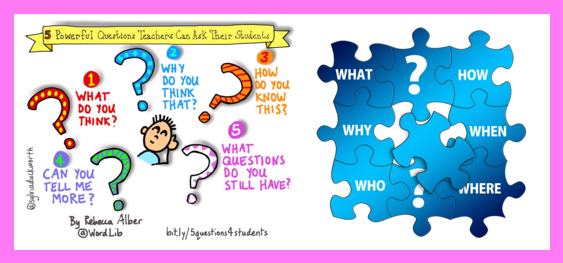

- Explanation:
- What is the concept in ….?
- What are examples of …. ?
- What are the characteristics/parts of …. ? Why is this so?
- How might we prove/confirm/justify …?
- How is … connected to … ?
- What are common misconception about …?
- Interpretation:
- What is the meaning of …?
- What does … reveal about … ?
- How is … like … (analogy/metaphor)
- How does …. relate to me/us?
- So what?
- Application:
- How and when can we use this (knowledge/process) … ?
- How is … applied in the larger world?
- How could we use … to overcome … (obstacle, constraint, challenge)?
- Perspective:
- What are different points of view about … ?
- How might this look from …. ‘s perspective?
- How is … similar to / different from … ?
- What are the strengths and weaknesses of … ?
- What are the limits of … ?
- What is the evidence for … ?
- Is the evidence reliable? Sufficient?
- Empathy:
- What would it be like to walk in …. ‘s shoes?
- How might … feel about … ?
- How might we reach an understanding about … ?
- What was …. trying to make us feel/see?
- Self Knowledge:
- How do I know …?
- What are the limits of my knowledge about … ?
- What are my blind sports about … ?
- How can I best show … ?
- How are my views about …. shared by … (experiences, assumptions, prejudices, values, style)?
- What are my strengths and weaknesses in … ?

The six facets of understanding can be used to scaffold and assess deeper levels of understanding targeted learning goals. The question stems above can be used to design question prompts for scaffolding and assessments activities that use the six facets of understanding.

Preparation Steps
- Analyze standards and determine which facets of understanding work best with standards expectations
- Use question prompts above to help design assessments and reflection prompts related to focus facets
Early Implementation Steps
- Use facet questions to give students formative feedback on their products and understandings so that students can refine these
- Use facet questions as diagnostic questions to check if activities are supporting students and to finetune activities
- Use facet questions to guide reflections and discussions about understanding learning goals
Advanced Implementation Steps
- Use 6 facets sentence stems as a tool to help students generate better knows and need-to-knows during project launch and throughout the project
- Convert question stems to sentence stems so that they can support student reflections on what they have already learned


